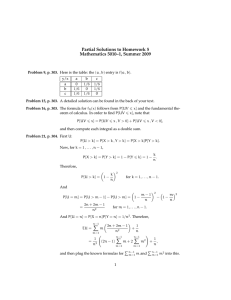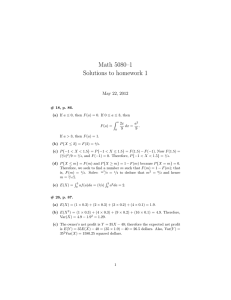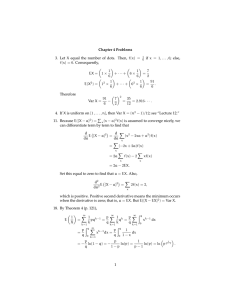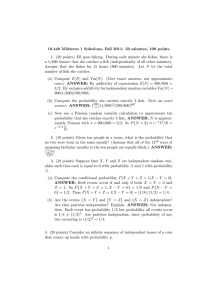Document 13434479
advertisement
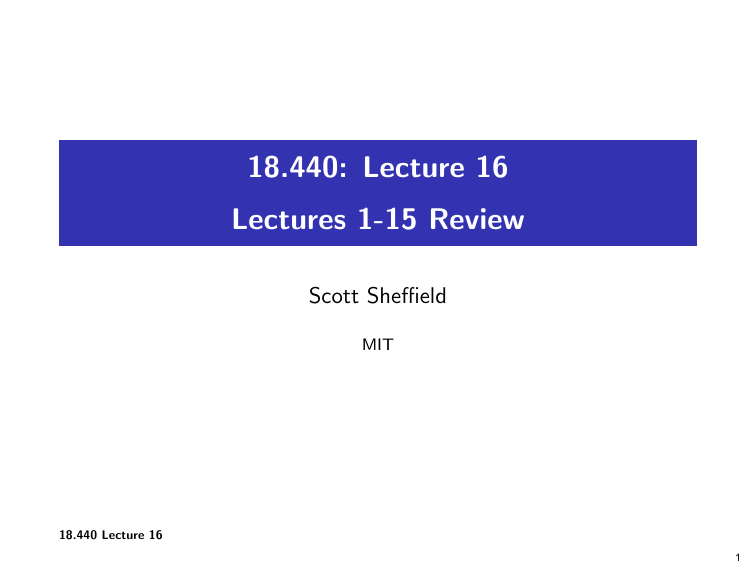
18.440: Lecture 16
Lectures 1-15 Review
Scott Sheffield
MIT
18.440 Lecture 16
1
Outline
Counting tricks and basic principles of probability
Discrete random variables
18.440 Lecture 16
2
Outline
Counting tricks and basic principles of probability
Discrete random variables
18.440 Lecture 16
3
Selected counting tricks
�
Break “choosing one of the items to be counted” into a
sequence of stages so that one always has the same number of
choices to make at each stage. Then the total count becomes
a product of number of choices available at each stage.
�
Overcount by a fixed factor.
�
If you have n elements you wish to divide into r distinct piles
of sizes n1 , n2 . . . nr , how many ways to do that?
�
Answer
�
How many sequences a1 , . . . , ak of non-negative integers
satisfy a1 + a2 + . . . + ak = n?
�
Answer: n+k−1
. Represent partition by k − 1 bars and n
n
stars, e.g., as ∗ ∗ | ∗ ∗|| ∗ ∗ ∗ ∗|∗.
n
n1 ,n2 ,...,nr
:=
n!
n1 !n2 !...nr ! .
18.440 Lecture 16
4
Axioms of probability
�
I
Have a set S called sample space.
�
I
P(A) ∈ [0, 1] for all (measurable) A ⊂ S.
�
I
P(S) = 1.
�
I
Finite additivity: P(A ∪ B) = P(A) + P(B) if A ∩ B = ∅.
�
I
Countable additivity: P(∪∞
i=1 Ei ) =
for each pair i and j.
∞
i=1 P(Ei )
if Ei ∩ Ej = ∅
18.440 Lecture 16
5
Consequences of axioms
�
I
P(Ac ) = 1 − P(A)
�
I
A ⊂ B implies P(A) ≤ P(B)
�
I
P(A ∪ B) = P(A) + P(B) − P(AB)
�
I
P(AB) ≤ P(A)
18.440 Lecture 16
6
Inclusion-exclusion identity
�
I
Observe P(A ∪ B) = P(A) + P(B) − P(AB).
�
I
Also, P(E ∪ F ∪ G ) =
P(E ) + P(F ) + P(G ) − P(EF ) − P(EG ) − P(FG ) + P(EFG ).
�
I
More generally,
n
P(∪ni=1 Ei )
P(Ei ) −
=
i=1
P(Ei1 Ei2 ) + . . .
i1 <i2
+ (−1)(r +1)
P(Ei1 Ei2 . . . Eir )
i1 <i2 <...<ir
n+1
= + . . . + (−1)
�
I
P(E1 E2 . . . En ).
P
The notation i1 <i2 <...<ir means a sum over all of the
subsets of size r of the set {1, 2, . . . , n}.
n
r
18.440 Lecture 16
7
Famous hat problem
�
I
n people toss hats into a bin, randomly shuffle, return one hat
to each person. Find probability nobody gets own hat.
�
I
Inclusion-exclusion. Let Ei be the event that ith person gets
own hat.
�
I
What is P(Ei1 Ei2 . . . Eir )?
�
I
Answer:
I
�
�
I
I
�
I
�
(n−r )!
n!
.
There are n
terms like that in the inclusion exclusion sum.
r
n (n−r )!
What is r n!
?
Answer: r1
! .
1
1
1
1
P(∪ni=1 Ei ) = 1 − 2!
+ 3!
− 4!
+ . . . ± n!
1
1
1
1
1 − P(∪ni=1 Ei ) = 1 − 1 + 2!
− 3!
+ 4!
− . . . ± n!
≈ 1/e ≈ .36788
18.440 Lecture 16
8
Conditional probability
�
I
Definition: P(E |F ) = P(EF )/P(F ).
�
I
Call P(E |F ) the “conditional probability of E given F ” or
“probability of E conditioned on F ”.
�
I
Nice fact: P(E1 E2 E3 . . . En ) =
P(E1 )P(E2 |E1 )P(E3 |E1 E2 ) . . . P(En |E1 . . . En−1 )
�
I
Useful when we think about multi-step experiments.
�
I
For example, let Ei be event ith person gets own hat in the
n-hat shuffle problem.
18.440 Lecture 16
9
Dividing probability into two cases
�
I
P(E ) = P(EF ) + P(EF c )
= P(E |F )P(F ) + P(E |F c )P(F c )
�
I
In words: want to know the probability of E . There are two
scenarios F and F c . If I know the probabilities of the two
scenarios and the probability of E conditioned on each
scenario, I can work out the probability of E .
18.440 Lecture 16
10
Bayes’ theorem
�
I
Bayes’ theorem/law/rule states the following:
P(A|B) = P(B|A)P(A)
.
P(B)
�
I
Follows from definition of conditional probability:
P(AB) = P(B)P(A|B) = P(A)P(B|A).
�
I
Tells how to update estimate of probability of A when new
evidence restricts your sample space to B.
�
I
So P(A|B) is
�
I
Ratio
P(B|A)
P(B)
P(B|A)
P(B)
times P(A).
determines “how compelling new evidence is”.
18.440 Lecture 16
11
P(·|F ) is a probability measure
�
I
We can check the probabilityPaxioms: 0 ≤ P(E |F ) ≤ 1,
P(S|F ) = 1, and P(∪Ei ) =
P(Ei |F ), if i ranges over a
countable set and the Ei are disjoint.
I
�
The probability measure P(·|F ) is related to P(·).
�
I
To get former from latter, we set probabilities of elements
outside of F to zero and multiply probabilities of events inside
of F by 1/P(F ).
�
I
P(·) is the prior probability measure and P(·|F ) is the
posterior measure (revised after discovering that F occurs).
18.440 Lecture 16
12
Independence
�
I
Say E and F are independent if P(EF ) = P(E )P(F ).
�
I
Equivalent statement: P(E |F ) = P(E ). Also equivalent:
P(F |E ) = P(F ).
18.440 Lecture 16
13
Independence of multiple events
�
I
Say E1 . . . En are independent if for each
{i1 , i2 , . . . , ik } ⊂ {1, 2, . . . n} we have
P(Ei1 Ei2 . . . Eik ) = P(Ei1 )P(Ei2 ) . . . P(Eik ).
�
I
In other words, the product rule works.
�
I
Independence implies P(E1 E2 E3 |E4 E5 E6 ) =
P(E1 )P(E2 )P(E3 )P(E4 )P(E5 )P(E6 )
= P(E1 E2 E3 ), and other similar
P(E4 )P(E5 )P(E6 )
statements.
�
I
Does pairwise independence imply independence?
�
I
No. Consider these three events: first coin heads, second coin
heads, odd number heads. Pairwise independent, not
independent.
18.440 Lecture 16
14
Outline
Counting tricks and basic principles of probability
Discrete random variables
18.440 Lecture 16
15
Outline
Counting tricks and basic principles of probability
Discrete random variables
18.440 Lecture 16
16
Random variables
�
I
A random variable X is a function from the state space to the
real numbers.
�
I
Can interpret X as a quantity whose value depends on the
outcome of an experiment.
�
I
Say X is a discrete random variable if (with probability one)
if it takes one of a countable set of values.
�
I
For each a in this countable set, write p(a) := P{X = a}.
Call p the probability mass function.
P
Write F (a) = P{X ≤ a} = x≤a p(x). Call F the
cumulative distribution function.
�
I
18.440 Lecture 16
17
Indicators
�
I
Given any event E , can define an indicator random variable,
i.e., let X be random variable equal to 1 on the event E and 0
otherwise. Write this as X = 1E .
�
I
The value of 1E (either 1 or 0) indicates whether the event
has occurred.
P
If E1 , E2 , . . . , Ek are events then X = ki=1 1Ei is the number
of these events that occur.
�
I
�
I
�
I
Example: in n-hat shuffle problem, let Ei be the event ith
person gets own hat.
P
Then ni=1 1Ei is total number of people who get own hats.
18.440 Lecture 16
18
Expectation of a discrete random variable
�
I
Say X is a discrete random variable if (with probability one)
it takes one of a countable set of values.
�
I
For each a in this countable set, write p(a) := P{X = a}.
Call p the probability mass function.
�
I
The expectation of X , written E [X ], is defined by
X
E [X ] =
xp(x).
x:p(x)>0
�
I
Represents weighted average of possible values X can take,
each value being weighted by its probability.
18.440 Lecture 16
19
Expectation when state space is countable
�
I
If the state space S is countable, we can give SUM OVER
STATE SPACE definition of expectation:
X
E [X ] =
P{s}X (s).
s∈S
�
I
Agrees with the SUM OVER POSSIBLE X VALUES
definition:
X
E [X ] =
xp(x).
x:p(x)>0
18.440 Lecture 16
20
Expectation of a function of a random variable
�
I
If X is a random variable and g is a function from the real
numbers to the real numbers then g (X ) is also a random
variable.
�
I
How can we compute E [g (X )]?
�
I
Answer:
E [g (X )] =
X
g (x)p(x).
x:p(x)>0
18.440 Lecture 16
21
Additivity of expectation
�
I
If X and Y are distinct random variables, then
E [X + Y ] = E [X ] + E [Y ].
�
I
In fact, for real constants a and b, we have
E [aX + bY ] = aE [X ] + bE [Y ].
�
I
This is called the linearity of expectation.
�
I
Can extend to more variables
E [X1 + X2 + . . . + Xn ] = E [X1 ] + E [X2 ] + . . . + E [Xn ].
18.440 Lecture 16
22
Defining variance in discrete case
�
I
Let X be a random variable with mean µ.
�
I
The variance of X , denoted Var(X ), is defined by
Var(X ) = E [(X − µ)2 ].
�
I
Taking g (x)P= (x − µ)2 , and recalling that
E [g (X )] = x:p(x)>0 g (x)p(x), we find that
Var[X ] =
X
(x − µ)2 p(x).
x:p(x)>0
I
�
Variance is one way to measure the amount a random variable
“varies” from its mean over successive trials.
�
I
Very important alternate formula: Var[X ] = E [X 2 ] − (E [X ])2 .
18.440 Lecture 16
23
Identity
�
I
If Y = X + b, where b is constant, then Var[Y ] = Var[X ].
�
I
Also, Var[aX ] = a2 Var[X ].
�
I
Proof: Var[aX ] = E [a2 X 2 ] − E [aX ]2 = a2 E [X 2 ] − a2 E [X ]2 =
a2 Var[X ].
18.440 Lecture 16
24
Standard deviation
�
I
Write SD[X ] =
Var[X ].
�
I
Satisfies identity SD[aX ] = aSD[X ].
�
I
Uses the same units as X itself.
�
I
If we switch from feet to inches in our “height of randomly
chosen person” example, then X , E [X ], and SD[X ] each get
multiplied by 12, but Var[X ] gets multiplied by 144.
18.440 Lecture 16
25
Bernoulli random variables
�
I
�
I
�
I
�
I
�
I
I
�
�
I
�
I
Toss fair coin n times. (Tosses are independent.) What is the
probability of k heads?
Answer: kn /2n .
What if coin has p probability to be heads?
Answer: kn p k (1 − p)n−k .
Writing q = 1 − p, we can write this as kn p k q n−k
Can use binomial theorem to show probabilities sum to one:
P
1 = 1n = (p + q)n = nk=0 kn p k q n−k .
Number of heads is binomial random variable with
parameters (n, p).
18.440 Lecture 16
26
Decomposition approach to computing expectation
�
I
Let X be a binomial random variable with parameters (n, p).
Here is one way to compute E [X ].
�
I
Think of X as representing number of heads in n tosses of
coin that is heads with probability p.
P
Write X = nj=1 Xj , where Xj is 1 if the jth coin is heads, 0
otherwise.
�
I
�
I
In other words, Xj is the number of heads (zero or one) on the
jth toss.
�
I
Note that E [Xj ] = p · 1 + (1 − p) · 0 = p for each j.
�
I
Conclude by additivity of expectation that
E [X ] =
n
X
j=1
E [Xj ] =
n
X
p = np.
j=1
18.440 Lecture 16
27
Compute variance with decomposition trick
�
I
P
X = nj=1 Xj , so
Pn
P
Pn Pn
E [X 2 ] = E [ i=1
Xi nj=1 Xj ] = i=1
j=1 E [Xi Xj ]
�
I
�
I
E [Xi Xj ] is p if i = j, p 2 otherwise.
Pn Pn
i=1
j=1 E [Xi Xj ] has n terms equal to p and (n − 1)n
terms equal to p 2 .
�
I
So E [X 2 ] = np + (n − 1)np 2 = np + (np)2 − np 2 .
�
I
Thus
Var[X ] = E [X 2 ] − E [X ]2 = np − np 2 = np(1 − p) = npq.
�
I
Can P
show generally
Pnthat if X1 , . . . , Xn independent then
Var[ nj=1 Xj ] = j=1
Var[Xj ]
18.440 Lecture 16
28
Bernoulli random variable with n large and np = λ
�
I
Let λ be some moderate-sized number. Say λ = 2 or λ = 3.
Let n be a huge number, say n = 106 .
�
I
Suppose I have a coin that comes on heads with probability
λ/n and I toss it n times.
�
I
How many heads do I expect to see?
�
I
Answer: np = λ.
�
I
Let k be some moderate sized number (say k = 4). What is
the probability that I see exactly k heads?
�
I
Binomial
formula:
n k
p
(1
−
p)n−k =
k
n(n−1)(n−2)...(n−k+1) k
p (1 −
k!
k
k
approximately λk! (1 − p)n−k ≈ λk! e −λ .
p)n−k .
I
�
This is
�
I
A Poisson random variable X with parameter λ satisfies
k
P{X = k} = λk! e −λ for integer k ≥ 0.
18.440 Lecture 16
29
Expectation and variance
�
I
A Poisson random variable X with parameter λ satisfies
k
P{X = k} = λk! e −λ for integer k ≥ 0.
�
I
Clever computation tricks yield E [X ] = λ and Var[X ] = λ.
�
I
We think of a Poisson random variable as being (roughly) a
Bernoulli (n, p) random variable with n very large and
p = λ/n.
�
I
This also suggests E [X ] = np = λ and Var[X ] = npq ≈ λ.
18.440 Lecture 16
30
Poisson point process
�
I
A Poisson point process is a random function N(t) called a
Poisson process of rate λ.
�
I
For each t > s ≥ 0, the value N(t) − N(s) describes the
number of events occurring in the time interval (s, t) and is
Poisson with rate (t − s)λ.
�
I
The numbers of events occurring in disjoint intervals are
independent random variables.
�
I
Probability to see zero events in first t time units is e −λt .
�
I
Let Tk be time elapsed, since the previous event, until the kth
event occurs. Then the Tk are independent random variables,
each of which is exponential with parameter λ.
18.440 Lecture 16
31
Geometric random variables
�
I
Consider an infinite sequence of independent tosses of a coin
that comes up heads with probability p.
�
I
Let X be such that the first heads is on the X th toss.
�
I
Answer: P{X = k} = (1 − p)k−1 p = q k−1 p, where q = 1 − p
is tails probability.
�
I
Say X is a geometric random variable with parameter p.
�
I
Some cool calculation tricks show that E [X ] = 1/p.
�
I
And Var[X ] = q/p 2 .
18.440 Lecture 16
32
Negative binomial random variables
�
I
Consider an infinite sequence of independent tosses of a coin
that comes up heads with probability p.
�
I
Let X be such that the r th heads is on the X th toss.
r −1
Then P{X = k} = k−1
(1 − p)k−r p.
r −1 p
�
I
�
I
Call X negative binomial random variable with
parameters (r , p).
�
I
So E [X ] = r /p.
�
I
And Var[X ] = rq/p 2 .
18.440 Lecture 16
33
MIT OpenCourseWare
http://ocw.mit.edu
18.440 Probability and Random Variables
Spring 2014
For information about citing these materials or our Terms of Use, visit: http://ocw.mit.edu/terms.



